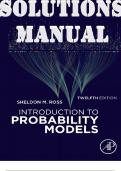, Solutions Manual For
Introduction to Probability Models 12th
Edition By Sheldon M. Ross
Chapter 1
1. S = {(R, R), (R, G), (R, B), (G, R), (G, G), (G, B), (B, R), (B, G), (B, B)}
The probability of each point in S is 1/9.
2. S = {(R, G), (R, B), (G, R), (G, B), (B, R), (B, G)}
3. S = {(e1 , e2 , . . . , en ), n ≥ 2} where ei ∈(heads, tails}. In addition, en = en−1 =
heads and for i = 1, . . . , n − 2 if ei = heads, then ei+1 = tails.
P{4 tosses} = P{(t, t, h, h)} + P{(h, t, h, h)}
� �4
1 1
=2 =
2 8
4. (a) F(E ∪ G)c = F E c G c
(b) E F G c
(c) E ∪ F ∪ G
(d) E F ∪ E G ∪ F G
(e) E F G
(f) (E ∪ F ∪ G)c = E c F c G c
(g) (E F)c (E G)c (F G)c
(h) (E F G)c
5. 43 . If he wins, he only wins $1, while if he loses, he loses $3.
6. If E(F ∪ G) occurs, then E occurs and either F or G occur; therefore, either E F
or E G occurs and so
E(F ∪ G) ⊂ E F ∪ E G
,2 Introduction to Probability Models
Similarly, if E F ∪ E G occurs, then either E F or E G occurs. Thus, E occurs and
either F or G occurs; and so E(F ∪ G) occurs. Hence,
E F ∪ E G ⊂ E(F ∪ G)
which together with the reverse inequality proves the result.
7. If (E ∪ F)c occurs, then E ∪ F does not occur, and so E does not occur (and so E c
does); F does not occur (and so F c does) and thus E c and F c both occur. Hence,
(E ∪ F)c ⊂ E c F c
If E c F c occurs, then E c occurs (and so E does not), and F c occurs (and so F does
not). Hence, neither E or F occurs and thus (E ∪ F)c does. Thus,
E c F c ⊂ (E ∪ F)c
and the result follows.
8. 1 ≥ P(E ∪ F) = P(E) + P(F) − P(E F)
9. F = E ∪ F E c , implying since E and F E c are disjoint that P(F) = P(E) +
P(F E)c .
10. Either by induction or use
n
∪ E i = E 1 ∪ E 1c E 2 ∪ E 1c E 2c E 3 ∪ · · · ∪ E 1c · · · E n−1
c
En
1
and as each of the terms on the right side are mutually exclusive:
P( ∪ E i ) = P(E 1 ) + P(E 1c E 2 ) + P(E 1c E 2c E 3 ) + · · ·
i
+ P(E 1c · · · E n−1
c
En )
≤ P(E 1 ) + P(E 2 ) + · · · + P(E n ) (why?)
�
i−1
36 , i = 2, . . . , 7
11. P{sum is i} = 13−i
36 ,i = 8, . . . , 12
12. Either use hint or condition on initial outcome as:
P{E before F}
= P{E before F|initial outcome is E}P(E)
+ P{E before F|initial outcome is F}P(F)
+ P{E before F|initial outcome neither E or F}[1 − P(E) − P(F)]
= 1 · P(E) + 0 · P(F) + P{E before F}
= [1 − P(E) − P(F)]
P(E)
Therefore, P{E before F} = P(E)+P(F)
13. Condition an initial toss
12
�
P{win} = P{win|throw i}P{throw i}
i=2
, Instructor’s Manual to Accompany 3
Now,
P{win|throw i} = P{i before 7}
⎧
⎪
⎪ 0 i = 2, 12
⎪
⎪ i −1
⎪
⎨ i = 3, . . . , 6
= 5+1
⎪
⎪ 1 i = 7, 11
⎪
⎪ 13 − i
⎪
⎩ i = 8, . . . , 10
19 − 1
where above is obtained by using Problems 11 and 12.
P{win} ≈ .49.
∞
�
14. P{ A wins} = P{ A wins on (2n + 1)st toss}
n=0
�∞
= (1 − P)2n P
n=0
∞
�
=P [(1 − P)2 ]n
n=0
1
=P
1 − (1 − P)2
P
=
2P − P 2
1
=
2− P
P{B wins} = 1 − P{ A wins}
1− P
=
2− P
16. P(E ∪ F) = P(E ∪ F E c )
= P(E) + P(F E c )
since E and F E c are disjoint. Also,
P(E) = P(F E ∪ F E c )
= P(F E) + P(F E c ) by disjointness
Hence,
P(E ∪ F) = P(E) + P(F) − P(E F)
17. Prob{end} = 1 − Prob{continue}
= 1 − P({H, H, H } ∪ {T, T, T })
= 1 − [Prob(H, H, H ) + Prob(T, T, T )].




